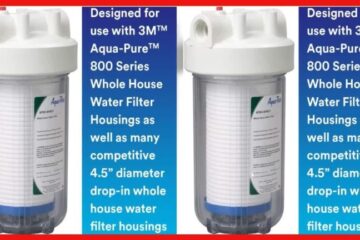In order to ensure the optimum conditions for your home, it is crucial to be aware of the quality of the water you use on a daily basis. Hard water, characterized by a high mineral content, can lead to a variety of issues ranging from appliance malfunctions to dull and dry skin. By understanding the telltale signs of hard water, you can take appropriate measures to mitigate its adverse effects. In this article, we will explore some effective ways to identify hard water in your home, enabling you to make informed decisions and maintain a pristine living environment.
Ways to Determine if You Have Hard Water
Perform a Visual Inspection
When it comes to identifying hard water in your home, performing a visual inspection is a good place to start. By examining various aspects of your home, you can gather clues that indicate the presence of hard water. Here are some key areas to focus on during your visual inspection:
Examine Glassware and Dishes
One of the most noticeable signs of hard water is the presence of cloudy or spotty glassware and dishes. If you frequently notice a white film or residue on these items after washing, it could be an indication of hard water. Hard water contains minerals such as calcium and magnesium that can bind with soap and form a film on glass surfaces.
Check Bathroom Fixtures
Another area to inspect is your bathroom fixtures, including faucets, showerheads, and taps. Hard water can leave mineral deposits on these fixtures, causing them to appear dull, stained, or discolored. Look for any white or yellowish build-up around the edges or in hard-to-reach crevices.
Look at the Inside of Kettles or Coffee Pots
Hard water can also leave its mark on your kitchen appliances. Take a look inside your kettle or coffee pot. If you notice a layer of mineral deposits or a white, chalky residue on the interior surfaces, it’s a strong sign that you have hard water. These deposits can affect the performance and efficiency of your appliances over time.
Look for Water Stains
Water stains can be a clear indication of hard water in your home. These unsightly marks left by the minerals in hard water can be found on various surfaces. Here’s where to look:
Inspect Faucets and Showerheads
Start by examining the faucets and showerheads in your home. Hard water can cause scale build-up on these fixtures, leading to unsightly stains. Look for white, brown, or orange discoloration around the edges of the fixtures or on the aerator screens.
Check Toilets and Bathtubs
Toilets and bathtubs are also susceptible to water stains caused by hard water. Inspect the rims of the toilet bowls and the surfaces of bathtubs for any signs of dark or discolored stains. These stains can be difficult to remove and may require extra cleaning effort.
Examine Dishwasher or Washing Machine
Another area to check is your dishwasher or washing machine. Hard water can cause residue and stains on the inner surfaces of these appliances. Look for any signs of white or brown build-up in the corners or on the walls of these machines.
Observe Water Spotting on Glass Surfaces
Glass surfaces such as windows, mirrors, and shower doors can be particularly prone to water spotting. Hard water can leave behind dried mineral deposits that create these spots. If you consistently notice water spots that are difficult to remove, it’s likely that you have hard water in your home.
Check Your Appliances
Hard water can have a detrimental impact on your household appliances. By examining the performance and condition of your appliances, you can gain insight into the presence of hard water. Here are some appliances to assess:
Inspect Your Dishwasher
Take a close look at your dishwasher. If you notice a buildup of limescale or mineral deposits on the interior surfaces or the spray arms, it can be a sign of hard water. Hard water minerals can clog the nozzles and reduce the efficiency of your dishwasher, resulting in less effective cleaning.
Examine Your Washing Machine
Similar to a dishwasher, a washing machine can also be affected by hard water. Look for any signs of limescale or mineral build-up in the detergent drawer, on the drum, or around the seals. Hard water can reduce the effectiveness of laundry detergents and leave your clothes looking dull and worn.
Check Your Coffee Maker or Kettle
Hard water can wreak havoc on your coffee maker or kettle. If you notice a crusty build-up or residue on the heating element or inside the water reservoir, it’s likely caused by hard water minerals. These deposits can affect the taste of your coffee or tea and reduce the overall lifespan of these appliances.
Look at the Inside of Your Water Heater
Your water heater can provide valuable insights into the condition of your water. If you find a layer of sediment or mineral deposits at the bottom of your water heater tank, it is a clear sign of hard water. These deposits can reduce the efficiency of your water heater and lead to higher energy costs.
Examine Your Plumbing
The plumbing system in your home offers further clues about the presence of hard water. By inspecting the various components of your plumbing, you can gather evidence of hard water. Consider the following areas:
Inspect Faucets and Showerheads
As mentioned earlier, faucets and showerheads are prone to mineral build-up caused by hard water. Take a closer look at these fixtures and check for white or brown deposits around the aerators or on the spouts. These deposits can restrict water flow and reduce the lifespan of your fixtures.
Check for Clogs in the Plumbing
Hard water can lead to the accumulation of mineral deposits in your plumbing pipes. This can cause clogs and blockages that affect water flow throughout your home. If you notice slow drains, recurring clogs, or reduced water pressure, it may be a result of hard water deposits.
Examine the Inside of Pipes or Waterlines
If possible, inspect the inside of your pipes or waterlines. Hard water minerals can accumulate over time, leading to a build-up known as scale. Look for any signs of scale such as flakes, discoloration, or rough texture on the inner surfaces of your pipes. Scale can restrict water flow and cause plumbing issues.
Look for Soap Scum
Soap scum is a common problem in households with hard water. The minerals in hard water can react with soap, forming a sticky residue that clings to surfaces. Here’s where to check:
Inspect Your Bathtub or Shower
Hard water can leave behind soap scum in your bathtub or shower. Check the walls, floor, and glass surfaces for a hazy film or a slimy texture. Soap scum can be difficult to remove and can make cleaning your bathroom a challenging task.
Check Bathroom Fixtures like Sinks or Drains
Don’t forget to examine bathroom fixtures such as sinks or drains. Hard water can cause soap scum to accumulate around the drain, making it prone to clogging. Look for any signs of a white or yellowish residue in and around these fixtures.
Observe Scaling on Fixtures
Scaling is another visible sign of hard water in your home. This occurs when the minerals in hard water deposit themselves on surfaces, resulting in a crusty, rough texture. Here’s where to look for scaling:
Check Faucets, Showerheads, and Taps
Inspect your faucets, showerheads, and taps for signs of scaling. If you notice any crusty or rough deposits on these surfaces, it is likely due to the mineral content in hard water. Scaling not only affects the appearance of your fixtures but can also lead to reduced water flow.
Look at the Bottom of Kettles or Coffee Pots
The bottom of your kettle or coffee pot can reveal the presence of scaling. Hard water minerals can build up over time, forming a thick layer on the base of these containers. If you notice a rough, flaky, or discolored surface at the bottom, it is a clear indication of scaling.
Examine the Surface of Bathroom or Kitchen Fixtures
Lastly, inspect the surface of your bathroom or kitchen fixtures for signs of scaling. Look for any rough patches, discoloration, or a powdery residue. These indicators can help you determine whether or not your home has hard water.
Test Your Water Pressure
Hard water can sometimes affect your water pressure. By monitoring the water pressure in your home, you can identify potential issues caused by hard water. Consider the following:
Notice Low Water Pressure
If you consistently experience low water pressure throughout your home, it could be a sign of hard water. Hard water minerals can accumulate in your pipes, leading to constricted flow and diminished pressure. If this issue persists, it may be worth investigating further.
Check for Blockages in Water Filters
If you have water filters installed in your home, check them for blockages. Hard water minerals can clog these filters, reducing their effectiveness and causing a drop in water pressure. Regularly inspect and clean your filters to maintain optimal water flow.
Observe Reduced Flow Rate in Appliances
Hard water can affect the flow rate of your appliances that rely on water, such as showers, faucets, and sprinklers. If you notice a significant decrease in water flow or uneven distribution, hard water may be to blame. Proper maintenance and regular cleaning can help mitigate these issues.
Notice Dry and Itchy Skin or Hair
One of the effects of hard water on your body is dry and itchy skin or hair. If you frequently experience these symptoms, it may be due to hard water. Consider the following signs:
Feel Dry Skin or Hair after Showering
Hard water can strip away the natural oils from your skin and hair, leaving them dry and dehydrated. If you consistently experience dryness after showering or bathing, it could be a result of hard water. Moisturizing creams and conditioners may provide temporary relief but addressing the root cause is essential.
Experience Itchiness or Irritation
In addition to dryness, hard water can cause itchiness and irritation on your skin. The minerals in hard water can lead to a pH imbalance, causing your skin to become more sensitive. If you notice persistent itchiness or irritation, particularly after exposure to water, it is worth investigating whether hard water may be the culprit.
Pay Attention to Dull and Lackluster Hair
If you find that your hair lacks shine and appears dull even after washing and styling, hard water may be to blame. The minerals in hard water can leave a residue on your hair, making it difficult for products to penetrate and provide the desired results. Pay attention to the texture and appearance of your hair to determine if hard water is the underlying issue.
Check Your Utility Bills
Hard water can also have financial implications. By monitoring your utility bills, you can identify any changes that may be attributed to hard water. Consider the following:
Monitor Increased Energy Costs
Hard water can reduce the efficiency of your water heater and other appliances, leading to increased energy consumption. If you notice a sudden spike in your energy bills without any other apparent cause, it’s worth investigating whether hard water may be contributing to the increased costs.
Note Higher Detergent or Soap Usage
Another financial impact of hard water is the increased consumption of detergent and soap. Hard water makes it more difficult for soaps and detergents to lather and dissolve effectively, resulting in the need for higher quantities. If you find yourself using more soap or detergent than usual, it’s worth exploring if hard water is to blame.
In conclusion, there are several ways to determine if you have hard water in your home. By performing a visual inspection, looking for water stains, checking your appliances, examining your plumbing, looking for soap scum, observing scaling on fixtures, testing your water pressure, noticing dry and itchy skin or hair, and monitoring your utility bills, you can accurately identify the presence of hard water. If you discover that you have hard water, there are various solutions and treatments available to mitigate its effects and ensure the optimal functioning of your home’s water system.



